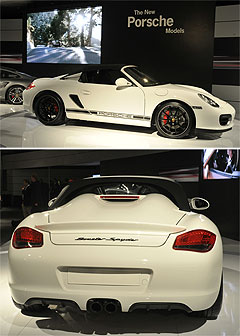Porsche spins Spyder details
BY BYRON MATHIOUDAKIS | 7th Dec 2009

Not only is that a little later than the Spyder’s anticipated arrival time, but Porsche Cars Australia (PCA) spokesman Paul Ellis also declined to reveal the exact price customers will be charged, owing to ongoing price negotiations as the company decides how to deal with the five per cent import duty drop that comes into effect from the beginning of 2010.
Right now the MY09 base Boxster retails for $114,800, while the MY09 S costs $141,900.
However, air-conditioning and an upgraded audio system with Bluetooth connectivity will be included on all Australian-bound Spyders.
These items, along with a host of other features deemed as anathema to the car’s high-performance focus, were deemed too heavy and were removed from the Spyder.

The Spyder joins the rest of the Boxster range as a mainstay in the Porsche line-up.
“The pricing of the car is still being determined and only because we are still adjusting our pricing to reflect the tariff reductions on January 1,” Mr Ellis told GoAuto at the car’s world premiere at the Los Angeles Show last week.
“So when that pricing has been finalised you can expect that the Spyder will carry about an eight per cent premium on the Boxster S – whatever the price of the 2010 Boxster S turns out to be.
“And in our market, our customers tend to have well-specified cars as standard so we will be putting features back into the car as standard – principally Porsche Communications Management which includes satellite navigation and iPod and Bluetooth functionality, and also air-conditioning. These critical elements will be standard in our cars.” To recap, the Boxster Spyder harks back to the mid-20th Century stripped-out, hard-core Porsche models such as the 550 and 356, weighing in at 1275kg instead of 1355kg – an 80kg difference.
Teamed up with a variation of the Boxster’s Cayman S cousin’s more powerful 235kW/370Nm 3.4-litre boxer six-cylinder engine, the Spyder boasts a leading power-to-weight ratio of 184kW per tonne, against the regular 228kW/360Nm Boxster S’s 170kW per tonne achievement.
The 0-100km/h dash is dismissed in 4.8 seconds by a Spyder fitted with the optional automated twin-clutch manual PDK transmission and Sports Chrono Package with launch control, while the same car is capable of returning 9.3 litres per 100km on the European combined cycle.
The Australian-bound Spyder may not quite hit these heights of efficiencies due to the increased specification.
But compared with a regular Boxster S, it will have special weight-saving belt-style door pulls instead of handles inside, redesigned bucket seats and alloy wheels, among other bespoke Spyder items.
Design wise, the car is easily recognised by its lower side windows, all-new lightweight (and manually-operated) canopy that replaces the regular Boxster’s automatic soft-top roof, twin rear bulges on a single-piece engine cover for a ‘double-bubble’ silhouette, restyled side air-intakes and an extended rear spoiler.
The Spyder also loses the daytime driving lights and fog lamps of its more mundane siblings.
The newcomer’s arrival in the second quarter of 2010 arrival is part of a busy year for PCA, with the second-generation Cayenne SUV also tipped to be in Australia before the year is out.